Asian Rhinoplasty: What Can You Expect? Is It Worth It?
In China and South Korea, plastic surgery is rapidly taking over. Employers are openly short-listing job candidates based mostly on their appearance, while job recruitment agencies hold fashion shows and beauty contests to ensure the potential employees have all the right qualifications.
As a result, undergoing a cosmetic surgery procedure has become an increasingly practical choice for Asians. No longer it is something only TV stars and new moms go for—in a world where one’s appearance matters more than a degree, plastic surgery becomes a hard-to-beat investment.
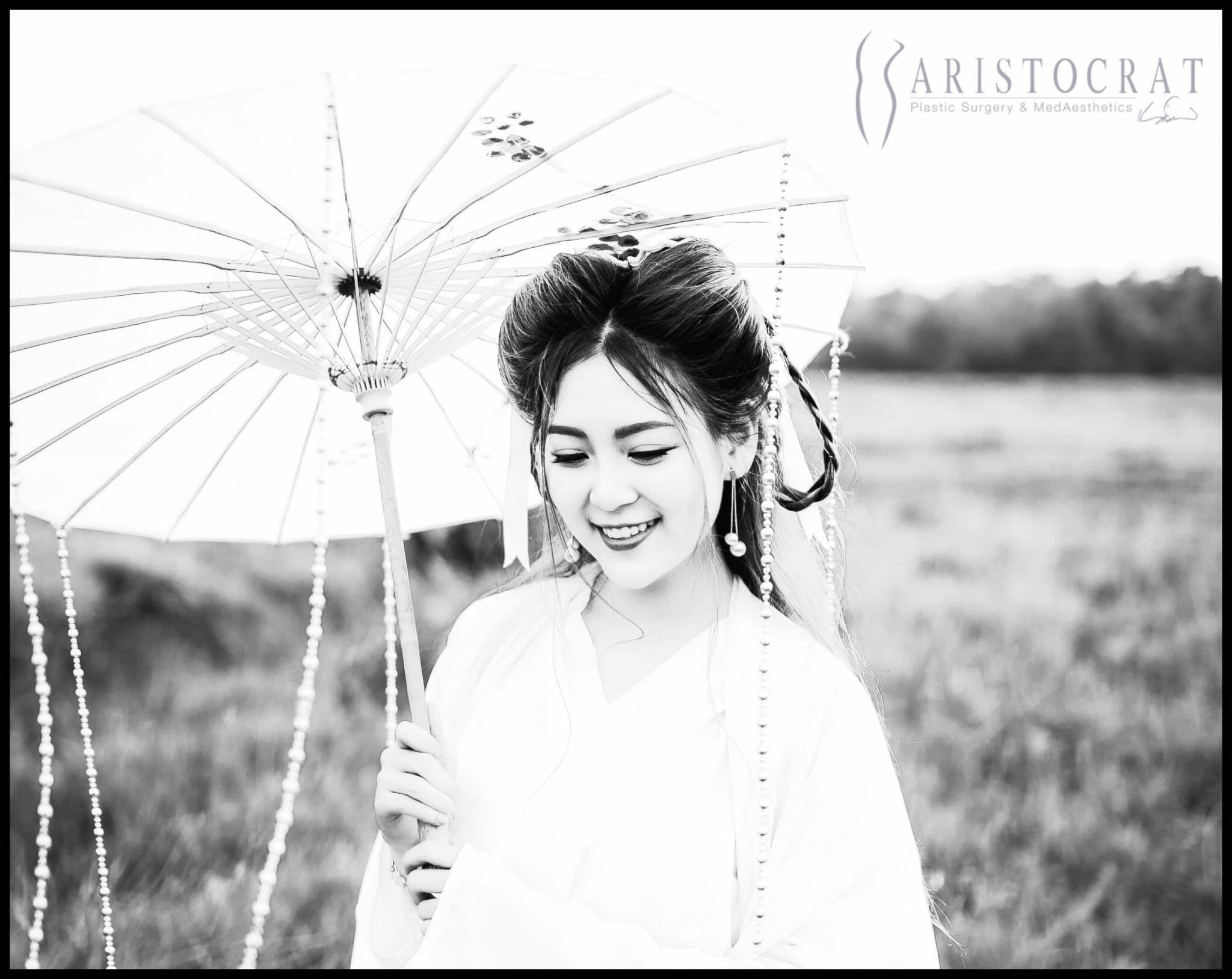
In the U.S., the story is similarly tangible, even if the workplace discrimination is much better hidden. Multiple major reports and surveys find that Asians are less likely to be promoted to senior management and executive positions. They also earn less on average.
People of Asian descent are well aware of this. Many of them are facing prejudice and discrimination from the early years—especially those who grow up here, in the U.S. “Sleepy eyes” and squared chins often become the subject of unfriendly jokes.
Given these facts, it is not difficult to understand why many people with Asian facial features are looking for adjustments.
Rhinoplasty—the technical term for a nose job—has emerged as one of the most popular procedures Asians go for. The flat, wider nose—typical to someone born in Asia—is no longer desirable. Instead, a pointy, narrow nose is idealized.
Asian Rhinoplasty Is Booming Worldwide
Rhinoplasty is quickly emerging as one of the go-to procedures for Asian demographics.
People of Asian descent are actively seeking to alter their facial traits. In fact, within Asia itself, the very concept of a beautiful nose is rapidly shifting—particularly in Japan, South Korea, and Singapore.
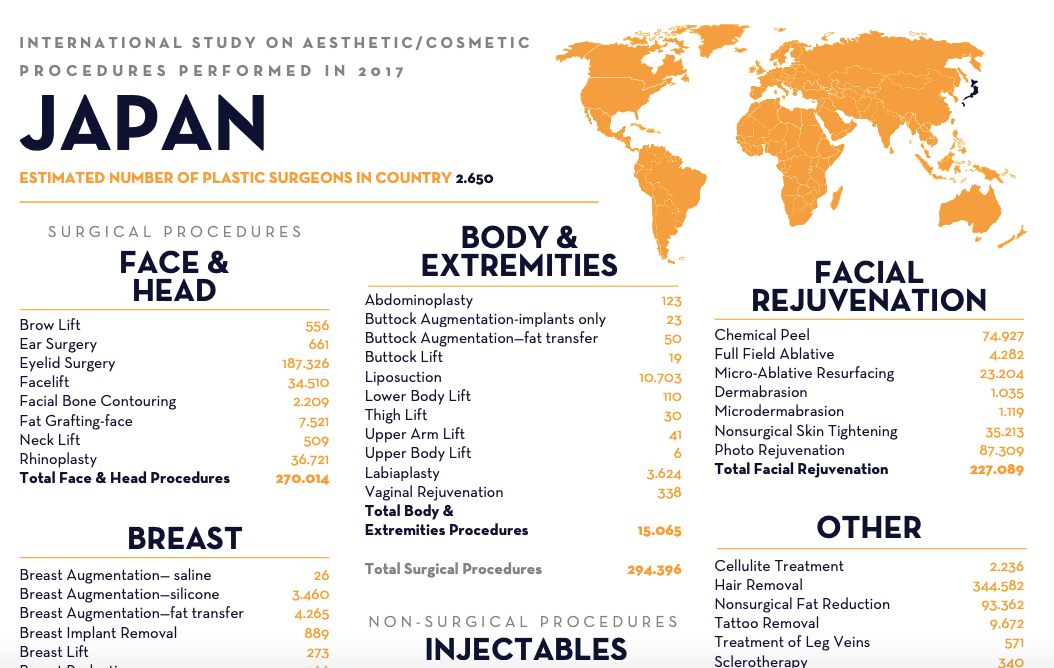
Is it the societal pressure that’s motivating young Asian women to go under the knife? Is it the increasing openness about plastic surgery in the media, the no-taboo ambassadorship by the young South Korean superstars?
More importantly—is this whole thing about looking more American, or is there more to it?
According to a report by Research and Markets, the cosmetic surgery market globally is worth $27 billion and it is set to rise to about $35 billion by 2021.
In 2012, reports have it that in the U.S., there was a 21% increase in the number of procedures requested by the Asian-American population, which was regarded as the highest among all ethnic groups in the U.S.
According to The American Society of Plastic Surgeons, a similar surge is being observed In Asia, particularly in South Korea, where most of the women seem to approach rhinoplasty as they would a haircut.

In 2011, more than 650,000 procedures of rhinoplasty were performed in South Korea, making it the country with the highest number of procedures performed in the whole of Asia.
About 1 out of 5 Asian women have undergone the procedure, compared to roughly 1 out of 20 women in the United States.
With the rising standard of living in most Asian countries, more women have been able to afford the cost of Asian rhinoplasty.
The cost of rhinoplasty can vary significantly, since two rhinoplasty procedures can be very different from one another. The prices can go from $12,000 for the simplest of procedures, while more complicated ones can cost as much as $40,000.
It is also important to note that Asian rhinoplasty is more common among young women when compared to young men.
A higher proportion of the urban population, especially among young people, go for the procedure as opposed to those who live in rural areas.
Many people dismiss this Asian rhinoplasty boom as an influence of the western culture, but that is a rude oversimplification.
To illustrate the extent of this mentality shift, consider for a moment that in Asian families, parents often bring their children to the clinics, financing their procedures. They’re doing so purely out of practical assumptions—to help their children succeed in their careers.
Overall, the Asian culture seems to have fully accepted and embraced cosmetic surgery. Unlike Americans, most Asians don’t consider it a taboo to admit they have gone under the knife. In 2012, for example, Miss South Korea confessed that she had gone under the knife when she said “I didn’t say I was born a beautiful person.”
What Exactly Is Considered a Beautiful Nose?
Besides its obvious function, the nose is a crucial determinant of our beauty. A centerpiece for our faces—so to speak—the nose has to be just right.
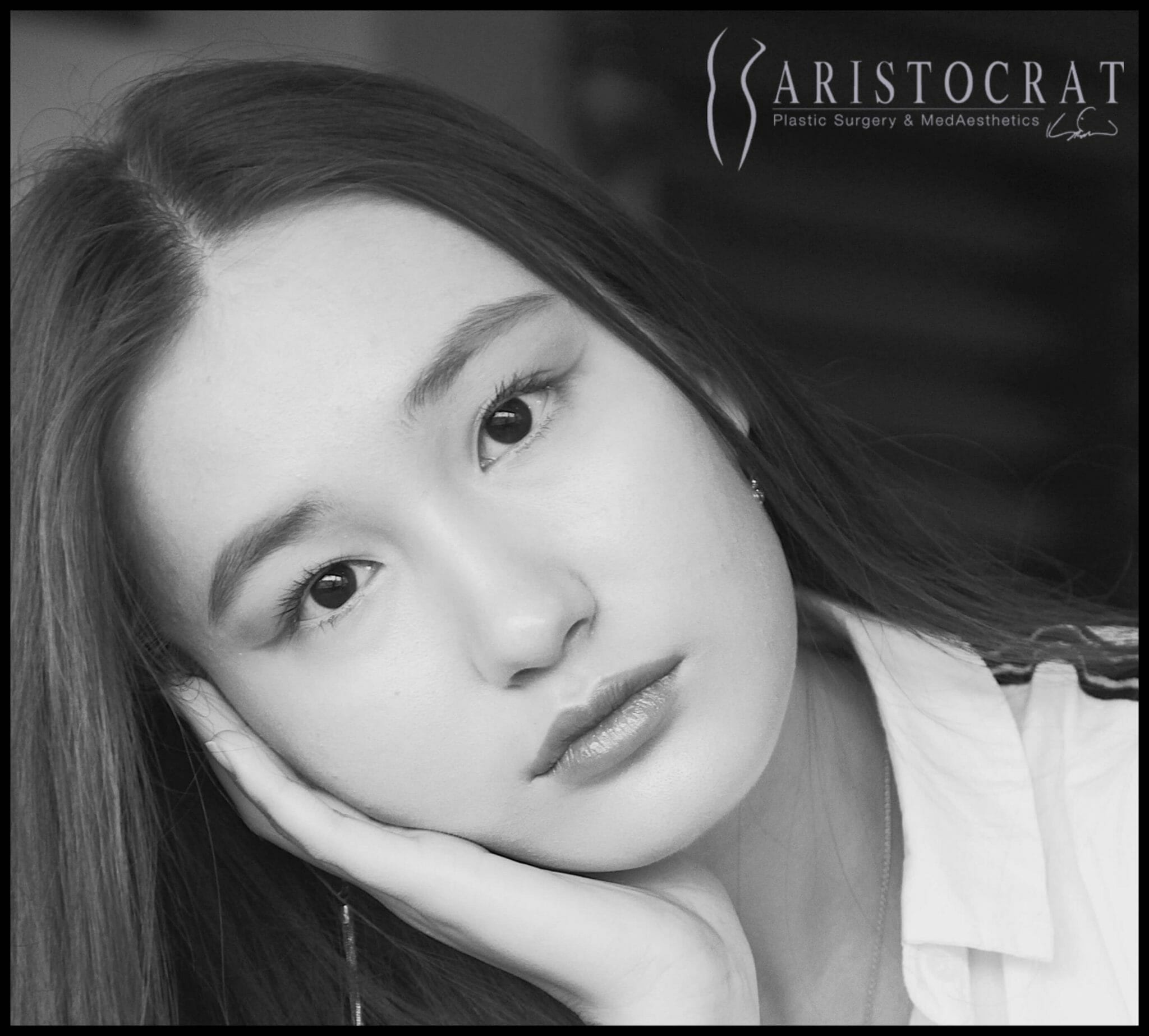
Ironically, the less prominent the nose is, the better it is for the owner. What this means is that, what most people call the ‘perfect nose’ is just the one that does not draw much attention to itself.
Cosmetic surgeons have come to conclude that, ideally, the cheeks, eyes and lips should get most of the attention. If the nose steals the show, it is usually bad news for its owner.
What Makes a Nose Beautiful?
Generally, it has been concluded that having an upturned nose will make women appear more feminine. According to some scientists, the perfect nose tip should be at an angle of exactly 106 degrees.
Although the general saying that beauty is in the eye of the beholder is still very much true, facial symmetry is considered the most universally accepted standard to measure beauty.
Humans are instinctively attracted to people who have superior facial symmetry and the perfect example can be found in Hollywood movies. Stars like Charlize Theron and Denzel Washington are considered the perfect examples of facial symmetry.
Another measure of beauty is the Golden Ratio (1.618). Also referred to as the Divine Proportion, this particular number has been regarded over the years as the perfect reflection of a standard proportion found in renowned works of art and architecture, as well as in nature.
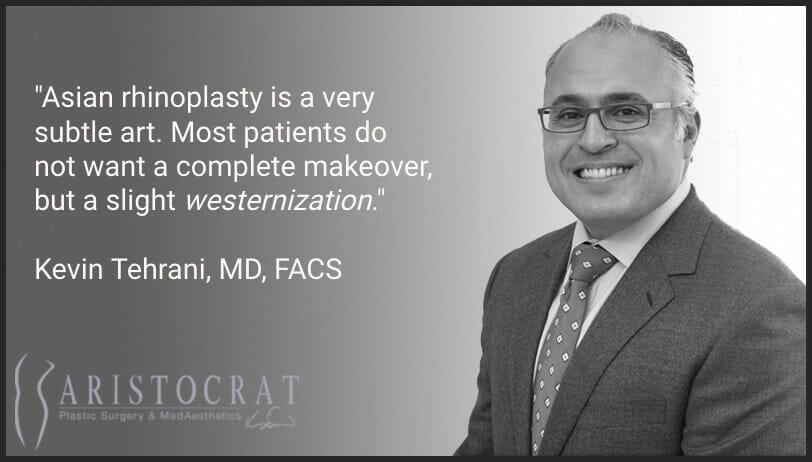
Most Asians, however, do not need Renaissance inspiration to figure out what looks good. As Asians generally have flatter and wider noses (compared to Caucasians), the request is usually to narrow down, and add to the tip projection when it comes to rhinoplasty. The result—a more westernized look.
Asian Noses vs. Caucasian Noses
Only surgeons who specialize in Asian rhinoplasty can understand the many nuances and intricacies of the Asian nose. In carrying out the procedure, it is important for the surgeon to preserve the ethnicity of the patient, while simultaneously satisfying their requests.
The motivation of the procedure among Asians is mostly to give the nose a pointier, narrower appearance without sacrificing the overall facial harmony.
Caucasians, in comparison, go for nose reductions much more frequently.
In some cases of Asian rhinoplasty, the only way to make the nose projection larger is to make an implant under the bridge of the nose and also the tip of the nose. It is often necessary because the Asian nose bridge is usually much flatter, and an implant has to be used to augment it.
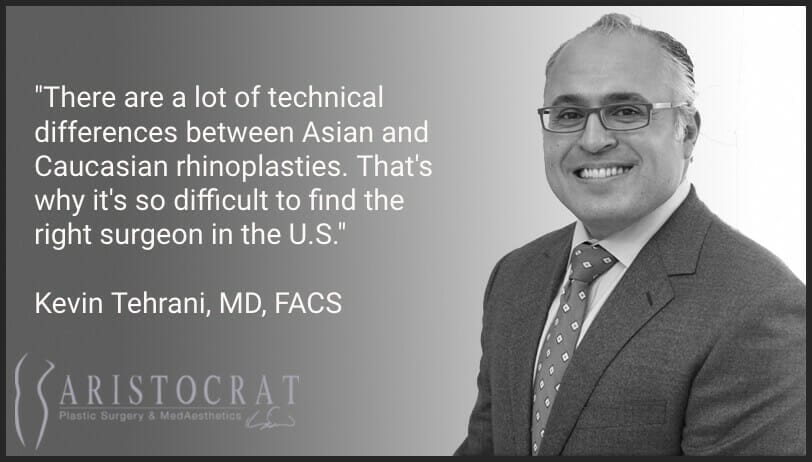
For Caucasians, we usually get away with some nasal manipulation, reshaping the nose and raising the tip slightly. For Asians, often times, the nose has to be built from the “ground up”, which dictates an entirely different set of techniques.
This makes true mastery of Asian rhinoplasty very rare, as even rich experience with Caucasian noses may not necessarily translate into Asian rhinoplasty qualifications.
During the procedure, especially in Asian patients, the goal is not to reshape the nose to look completely Caucasian. The goal is to have the nose reshaped to fit into the surrounding facial features in such a way that promotes balance and harmony, while adding an accent or two of a more westernized look.
In rhinoplasty, the nose has to be treated differently from that of a Caucasian in order to avoid:
- Poor Tip Projection: Treating the Asian nose just as the Caucasian nose will involve the removal of tissue from the nose tip to narrow the area, which involves the use of suture techniques to create the desired shape through the folding of the cartilage. This technique, however, can lead to an undesirable outcome. The main reason for this is that the Asian patients have weaker cartilages at the tips of their noses, which usually render traditional techniques ineffective.
- An overly large bridge: Without adequate knowledge of the Asian aesthetics (when it comes to the nose appearance), a surgeon is likely to build up the bridge of the nose too high. In those cases, the rhinoplasty may produce results more characteristic to a Greek look rather than a modified Asian one.
What Is Asian Rhinoplasty?
Asian rhinoplasty is a broad term, which refers to a set of rhinoplasty techniques that are commonly requested among the Asian population. Categorizing patients according to their ethnic group is very important in the procedure, since wrong techniques can produce unsatisfactory results.
Evolution of Asian Rhinoplasty
Over time, Asian Rhinoplasty has evolved from what used to be a closed technique and silicone implants into a more open technique that involves specific improvements to the nasal tip, bridge, and nasal base.
This evolution has been triggered by the increase in the affluence of Asian patients and an increase in demand from individuals that would love to have a nose that fits more on the Asian face rather than a purely “Western nose”.
The upper area of the nose is made of bones, while the lower area is made of cartilage. Rhinoplasty has the potential to manipulate the cartilage, the bones, and the skin, or even all three. It is best to consult with your surgeon on which particular technique could fit your goals and expectations most precisely.
While planning for rhinoplasty, the surgeon will consider your overall facial features, the skin on the nose and what type of final look you are after. If the surgeon accepts you as a candidate for surgery, he or she will then come up with a customized plan for your needs.
Why Rhinoplasty?
Apart from the aesthetic purpose of undergoing rhinoplasty, the procedure can also be carried out to fix inborn deformities or treat a medical condition:
- Injury. Did you know that the nose is the most frequently broken bone in the head? While an unfortunate street fight or a bad hit during a boxing match can result in a fracture, it is far from being the only cause for a broken nose. Nasal injuries usually surface as extreme pain, excessive nose bleeding, difficulty breathing through the nose, and dark bruises around the eyes.
- Birth defects. Some nasal deformations haunt people from birth. While parents usually opt to fix these within 3-6 months after the birth of the child, in less severe cases, people choose to live out their lives without addressing the issue. Luckily, rhinoplasty can easily fix inborn defects such as cleft palates.
- Breathing problems. One of the most common medical issues people request rhinoplasty is because they have trouble breathing through both nostrils. Usually this issue occurs as a result of a collapsed nasal septum—the divider inside your nose, so to speak. In plain English, if the nasal septum collapses, you’ll have a hard time breathing through one of your nostrils. Unlike a cold, this condition won’t go away on its own.
Asian Rhinoplasty vs. Caucasian Rhinoplasty
While the end goal is always the same—to build a better appearance—the means of getting there can vary significantly between people of Asian and Caucasian ethnicities.
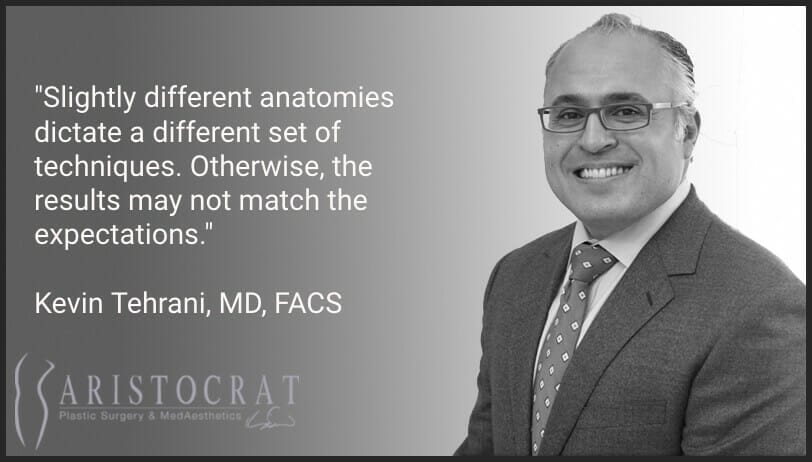
Here are some of the major differences in rhinoplasty between the two populations:
- Osteotomies: Unlike in Asian rhinoplasty—which mostly relies on augmentation—Caucasian nose jobs may sometimes require significant bone manipulation, which involves breaking and reshaping of the bones in the nose. Osteotomies—the medical term for the manipulation of the bone—are only performed in about 10% of the Asian patients (mostly in those who want to narrow down their nose.)
- Implants: Since most Asian rhinoplasty procedures are done to increase projection of the nose tip, implants are used less commonly for Asian rhinoplasty, compared to the Caucasian procedures.
- Inadequate projection: As we’ve mentioned before, most Caucasians seek to reduce their nose size, while Asians—who are commonly born with flatter, wider noses—will usually ask the surgeon to increase their nasal projection.
Common Errors Seen in Asian Rhinoplasty
Due to the unique nature of Asian rhinoplasty, often times surgeons fail to deliver the expected result.
For instance, the surgeon might narrow the nostrils surgically to create a pasted-on appearance, use implants in the nasal tip in a visible, artificial way, or even unnecessarily perform bone manipulation, which can lead to an unnatural nasal contour or an uneven bone position.
Generally, most errors occur in regards to the nasal tip and the nasal bridge.
While trying to reinforce the nasal bridge, inexperienced surgeons can accidentally make it unnaturally large.
Another mistake that is being made by most surgeons is the unnecessary removal of cartilage from the nasal tip in the attempt to make the nose look narrower. The problem is that a weak nasal tip on the nose—common among Asians—is not the result of too much cartilage, as it is with Caucasian noses, but merely a sign that the cartilage is weak, and needs to be reinforced.
So, in the case of Asian rhinoplasty, removing the cartilage or using sutures to fold the tip into that appropriate shape may lead to unfavorable results. What should be done here is the tip should be buttressed with additional cartilage from the ear or septum to project the nasal tip upward and, at the same time, provide reinforcement.
How Does the Asian Rhinoplasty Procedure Go?
Before the Procedure
Before actually undergoing the procedure, all patients are scheduled consultation appointments to discuss the important factors that will determine if the surgery is going to work for them or not.
During your initial meeting with the surgeon, you will talk about:
- Goals and Expectations: The number-one question you will be asked by the surgeon is the goal and the motivation behind the surgery. Sometimes, the expectations may simply be unrealistic in terms of what a single rhinoplasty procedure can achieve. In those cases, the patient is either rejected or an alternative procedure is offered.
- Your Medical History: The surgeon will want to know about your medical history, which will include a history of previous surgeries, nasal obstruction and any medication you are taking. The doctor will also want to understand if you have any bleeding disorders, which could make you a bad candidate for the procedure.
- Physical Exam: The surgeon will need to conduct a physical examination on you. This will include blood tests and a few other lab tests. Your facial features will be examined as well as the outside and the inner part of your nose. This physical examination will help the doctor determine the changes that will have to be made to your physical features, which include the thickness of your skin and the strength of the cartilage in the nasal tip. It will also determine the impact of rhinoplasty on any potential breathing issues.
- 3D Modeling: With regards to the end result you’re after and your current nose shape, 3D-assisted images will be modelled to illustrate how the end result might look like after the procedure. This helps keep everyone on the same page and expectations under control.
You might feel a little bit self-conscious to discuss your appearance with the surgeon, but it is important to note that you have to be open about your goals and desires for the surgery.
If your chin is relatively small, the doctor may suggest an augmentation of the chin through another surgery. This is simply because a small chin makes your nose look larger. Though this is not necessary, you might want to consider the option if you’re open to a larger profile of facial adjustments.
Once the surgery has been scheduled, you will need to make arrangements for someone to drive you home if you are an outpatient. It is not recommended to drive yourself after undergoing surgery.
It is also important to note that during the first few days after the surgery, you might experience memory lapses, impaired judgment and slow reaction time—a possible side effect from the anaesthesia.
For that reason, you might want to make arrangements with family members to stay with you for a day or two and help you with your daily chores while you safely recover.
The Rhinoplasty Procedure
The rhinoplasty procedure is carried out inside the nose or through a small incision at the base of the nose. The procedure might entail the surgeon readjusting the cartilage and bone under your skin.
The shape of your cartilage and the nasal bones can be changed in many ways, depending on how much needs to be added or removed, the structure of the nose and the materials available.
For small changes, the surgeon may make use of cartilage taken from deep inside the nose or from the ear. For larger changes, they can use cartilage from your rib or bones in other parts of the body.
Once the changes are made, the surgeon places the nose skin and tissues back to their designated positions and then stitches the incisions made on the inside of the nose.
If the wall between the 2 sides of your nose is crooked or bent, the doctor can also make corrections to that to help improve breathing.
Does Rhinoplasty Leave Visible Scars?
In short, no. Dr. Tehrani makes incisions on the inside of the nose, which are not visible from the outside.
Anesthesia Used During Rhinoplasty
During the procedure, the surgeon might use general anesthesia or local anesthesia with sedation, which will depend on how complex the surgery is and the techniques preferred by the surgeon.
It is best to discuss this with your surgeon before the procedure on which anesthesia is the most appropriate for you:
- General Anesthesia: The anesthetic will be inhaled or administered through a small tube that will be placed in a vein in your hand, chest or neck. General anesthesia will affect the entirety of your body and you will be unconscious throughout the surgery. You will breathe through a facial mask connected to a breathing tube, to make sure you maintain the oxygen levels.
- Local anesthesia with sedation: This type of anesthesia is limited to a certain part of the body. The local anaesthetic is injected into several locations around the surgical site, to completely numb down the area. Additional medication is often used for extra sedation. This will make you groggy, but you won’t be fully asleep.
After the Surgery
After the operation is finished, you will rest in bed for a while, with your head raised higher than the chest—to reduce swelling and bleeding. It is likely to have your nose congested because of the swelling from the splints that will be placed within your nose.
Most times, the internal dressing will remain in place for about seven days after the procedure— the splint is taped to the nose for support and protection.
Slight bleeding and drainage of blood and mucus will be experienced a few days after the surgery or even after the dressing is removed. A drip pad may be placed under your nose to absorb the drainage. You will also be given guidelines on how to change the drip pad or gauze (make sure to not place it too tight to your nose!)
You may also be asked to follow these guidelines for several weeks after the surgery, to speed up the recovery and lower swelling/bleeding:
- Avoid strenuous activities such as jogging and aerobics.
- The bandage should be on your nose while bathing (it is preferred that you take baths rather than showers.)
- You will be unable to blow your nose at the start.
- Eat foods that contain high amounts of fiber, such as vegetables and fruits, to avoid constipation. You can strain your body during constipation, which will put more pressure on the surgical site.
- It is best to avoid extreme facial expressions as laughing and smiling.
- You will have to brush your teeth gently to limit the movement of the upper lip.
- Do not pull clothes over your head. Wear clothes that fasten in the front.
Additionally, do not rest sunglasses on your nose for at least four weeks after the procedure. This is to prevent unnecessary pressure on the nose. As funny as it sounds, you can tape the glasses to your forehead.
It is also recommended that you use SPF sunscreen when you are not inside, most especially on the nose. When your nose receives too much sun, it leads to discoloration.
Remember that the swelling may take longer than expected, so limiting the intake of dietary sodium will help the swelling disappear faster. Do not place ice packs on the nose after the rhinoplasty procedure, as it could only slow down the healing process.
The nose will experience changes throughout your life whether you undergo surgery or not. So it is difficult to say when a patient has obtained the ‘final result’. The swelling will disappear entirely within a year—that’s when you’ll be able to judge the results most clearly.
Medications and Food
It is generally recommended to avoid medications that contain aspirin or ibuprofen for 2 weeks before and after the surgery, as these medications may increase bleeding. Your surgeon will recommend the medications that you be able to use.
You also need to stay away from smoking as this will slow down the healing process after the procedure. Slower healing means a higher chance of infection and a longer recovery.
The Results
Even the tiniest of changes made to the nose can make a large difference on the overall appearance. These changes are often measured in millimeters.
Almost all of the time, a skilled surgeon will achieve the result that both of you will be satisfied with. In some cases, the slight changes might be considered not enough and there will be the need to undergo a second surgical operation to achieve the desired changes.
If that is the case, then the best time to wait before another follow-up procedure is a minimum of a year. The primary reason for that is that the nose itself can undergo some changes within that period.
How Long is the Recovery Period?
After the operation, patients will need to wear a splint for at least a week. They will begin to feel better each day in the first week of the procedure. One week after the procedure, most people feel like themselves again. You should expect to return to work within 2-3 weeks after a rhinoplasty procedure.
Note that there will be some swelling after the surgery, which can take months to resolve. Most of the time, people return to day-to-day activities after a week and resume all their—such as exercise—activities within four weeks of the procedure.
It is also important to understand that every patient is different. The surgeon will make recommendations based on what he observes in the patient as well as the type of surgical techniques used in the rhinoplasty.
Even if you feel good after the procedure within the 1st week of your recovery, it is not advisable to resume exercising immediately. Doing this will interfere with the healing process and might even cause unexpected bleeding.
Exercises can increase the blood pressure as well as the heartrate, so you should avoid any form of exercising until the 6th week from the time of the procedure.
For a full guide on rhinoplasty recovery, click here.
Final Verdict: The Key Is to Find the Right Surgeon
Asian rhinoplasty is different from traditional rhinoplasty, both in terms of patient expectations and the actual techniques used during the procedure.
That’s why the most important decision you will make in your transformational journey is choosing the right surgeon for the job.
Make sure to ask for previous Asian rhinoplasty before-after photos to make sure your doctor is able to deliver the results you’re after. While 3D modelling will help you get on the same page, you still want to make sure your surgeon has the right experience.

